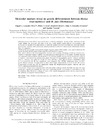Identificador persistente para citar o vincular este elemento:
https://accedacris.ulpgc.es/jspui/handle/10553/53684
| Título: | Molecular markers reveal no genetic differentiation between Myrica rivas-martinezii and M-faya (Myricaceae) | Autores/as: | González Pérez,Miguel Ángel Sosa, Pedro A. Rivero, Elisabeth González González, Edna Amada Naranjo Cigala, Agustín |
Clasificación UNESCO: | 241714 Genética vegetal 240903 Genética de poblaciones |
Palabras clave: | Conservation genetics Canary Islands Microsatellites Myrica rivas-martinezii Myrica faya, et al. |
Fecha de publicación: | 2009 | Proyectos: | Caracterización Genética y Demoráfica de Las Poblaciones Naturales de Tres Endemismos Vegetales Canarios Amenzados Como Estrategia Para El Desarrollo y Aplicación de Un Plan de Conservación | Publicación seriada: | Annals of Botany | Resumen: | Background and Aims Myrica rivas-martinezii is a critically endangered endemic of the laurel forest of the Canary Islands and co-occurs very close to M. faya. Some authors suggest that M. rivas-martinezii and M. faya are two morphs of the same species, so molecular markers were used to estimate the levels and structuring of genetic variation within and among natural populations in order to evaluate genetic relationships between these two congeners. Methods Six polymorphic microsatellite (simple sequence repeat, SSR) markers were used to determine the genetic diversity and the genetic relationship between both Myrica species. Key Results Most of the natural populations analysed were in Hardy–Weinberg equilibrium for both taxa. Analysis of molecular variance (AMOVA) for both species revealed that most of the genetic variability detected was contained within populations (92·48 and 85·91 % for M. faya and M. rivas-martinezii, respectively), which it is consistent with outcrossing and dioecious plants. Estimates of interpopulation genetic variation, calculated from FST and G′ST, were quite low in the two taxa, and these values did not increase substantially when M. rivas-martinezii and M. faya populations were compared. The UPGMA dendrogram based on Nei's genetic distance clustered the populations by their island origin, independently of taxon. In fact, the mixture of individuals of both taxa did not appreciably disrupt the intrapopulational genetic cohesion, and only 3·76 % variation existed between species. Conclusions All the results obtained using molecular markers indicate clearly that both taxa share the same genetic pool, and they are probably the same taxa. Considering that M. rivas-martinezii is classified as at risk of extinction, there should be a change of focus of the current management actions for the conservation of this putatively endangered Canarian endemic. | Descripción: | Financial support has gratefully been received from the MAEC-AECI Fellowship for the PhD studies of E.A.G.-G. | URI: | https://accedacris.ulpgc.es/handle/10553/53684 | ISSN: | 0305-7364 | DOI: | 10.1093/aob/mcn222 | Fuente: | Annals of Botany [ISSN 0305-7364], v. 103 (1), p. 79-86, (2009) |
| Colección: | Artículos |
Citas SCOPUSTM
28
actualizado el 08-jun-2025
Citas de WEB OF SCIENCETM
Citations
28
actualizado el 08-jun-2025
Visitas
82
actualizado el 12-oct-2024
Descargas
68
actualizado el 12-oct-2024
Google ScholarTM
Verifica
Altmetric
Comparte
Exporta metadatos
Los elementos en ULPGC accedaCRIS están protegidos por derechos de autor con todos los derechos reservados, a menos que se indique lo contrario.
